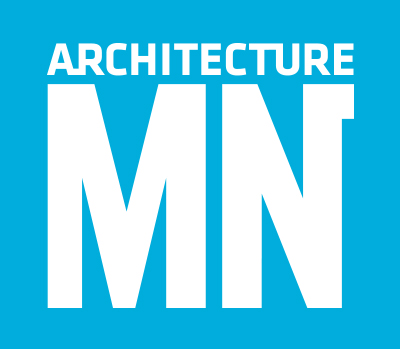Musings on the corrugated-metal craze in multifamily housing
By Andy Sturdevant
Former Minneapolis mayor R.T. Rybak is on record, I believe, as saying his favorite building in Minneapolis is Frank Gehry’s Frederick R. Weisman Art Museum at the University of Minnesota. I think it’s a sentiment shared by many Twin Citians of his generation. It’s especially common among those, like R.T., with an interest in the public perception of the cities as a forward-looking modern metropolis. In the days before the Walker expansion and the new Guthrie, the Weisman was the savvy graphic designer’s best friend when some visual shorthand for the dynamism of the Twin Cities was required for print publication purposes. In fact, the first guidebook to the Twin Cities I ever purchased, in 2004 or so, had the Weisman front and center. Before I even moved here, I knew what the Weisman looked like.
When Gehry’s museum crested the bluffs of the Mississippi River in 1993, steel gleaming in the sunlight, it was an instant standout civic attraction, an architectural statement that was, in a particularly Minnesotan way, just the slightest bit ahead of the curve. Just the slightest bit—tiptoeing right to the line of immodesty but not quite crossing it. When it opened, Star Tribune architectural critic Linda Mack wasn’t sure whether it was “a Martian spacesuit of a museum” or “a pile of tin.” In her first preview of the building, she called it both, in the space of three sentences.
As Mack’s ambiguity suggests, metal can seem simultaneously cosmic and colloquial in a way no other material can. It can reflect the surroundings, both literally and metaphorically. All that metal on the Weisman not only reflected the wide-open prairie sky into the water; it also suggested a monolithic industrial past wrapped in steel cladding, a past that had been tidied up, modernized, and streamlined into something novel and chic. What early 21st-century urban mayor wouldn’t gaze upon that tableau—a picturesque metaphor for the economic revitalization of the riverfront—and smile fondly?
BROWN OR GUNMETAL GRAY
It’s hard to say how national trends intersect with local trends, but I often wonder if the presence of the Weisman in the collective consciousness gave Twin Cities architects and builders a taste for metal. In the past decade, as mixed-use buildings have sprouted up around the denser precincts of the cities, an inescapable feature has been panels of corrugated metal. In Minneapolis, think of the residential developments in Uptown, or in the Warehouse District, or especially student rental properties by the U. The image that comes to mind is a four- or five-story building, boxy in shape, suspended balconies uniformly barnacled to the sides, and the exterior clad in brown, taupe, and gray EIFS panels. The rental properties in particular take a let’s-try-four-or-five-materials approach to design.
Mixed in there, invariably, are sheets of corrugated aluminum. Sometimes they’re brown, but often they’re a buffed gunmetal gray, not much different in color or form from the industrial sheds that sat on these sites not that long ago. They add a touch of what you might call either a postmodern sleekness or a post-industrial grittiness, depending on your mood.
In fact, this type of corrugated-metal accent on new apartment buildings is so pervasive it’s metastasized into cliché. When people complain about new trends in multifamily residential architecture—and oh, they do, all over the Internet—it’s usually the corrugated metal that’s singled out.
“I’ve seen more attractive pole barns,” one Internet commenter complained about a proposed development in the Warehouse District several years ago. “Was there a deal going on with brown corrugated sheet and they figured they should build something with it?” Assigning partial blame to the City of Minneapolis’ design guidelines, Thomas Fisher, then dean of the University of Minnesota’s College of Design, wrote a newspaper editorial in 2015 decrying the “cluttered patchworks of metal, brick, stone, and glass, as if concocted by a number of collage artists.” Fisher didn’t mean that as a compliment, but his evocation of a spectral collective of materials-crazed artists throwing up whatever construction-site junk they could get their hands on is instructive. Initially, it was artists, doing just that.
CRADLE OF THE CRAZE
This trend is not specifically a Minnesota phenomenon—you see it in cities all over the U.S.—and neither are these critiques. But returning to Gehry’s landmark museum on the Mississippi River and his architecture career as a whole may give some insights into how corrugated metal went from avant-garde eccentricity to developer cliché in the space of 30 years. As with many of these origin stories in American culture, we can locate the earliest stirrings in Southern California.
Before Gehry was the signature starchitect of the era, he was just another young sculptor knocking around the Southern California art scene in the 1960s. The Los Angeles art scene was distinct from the elite New York scene of the same time: less snobby, more egalitarian, more likely to draw on the American vernacular in both content and form. Think of Ed Ruscha’s gas stations, stretching off into infinity on an endless concrete and steel freeway. An early Gehry collaborator was the Angeleno sculptor and painter Billy Al Bengston, whose interest in motorcycles and the automotive culture of California manifested itself in artworks incorporating banged-up hunks of steel; in an early sculpture, he depicted himself on a motorcycle, bedecked in a racing jumpsuit and looking ready to jump through a flaming hoop. It wasn’t all show—Bengston really did race motorcycles semi-professionally.
He and Gehry collaborated on a Los Angeles County Museum of Art retrospective of Bengston’s work in 1968—Gehry built the scenography for the show, the entrance to which was a wall of stark, corrugated-steel forms salvaged from around the museum’s storage facilities and nearby sites. “They didn’t have any money to do anything new, and I said we would use the old materials,” Gehry later recalled. “I guess maybe I told them we’d paint it, but then when it got up it looked so great that we kept it up.”
As Gehry became more involved in architecture, he made it a point to use salvaged materials, including steel. A major professional (and personal) project that gained him some early attention in the 1970s was his own bungalow in Santa Monica, which he had clad in corrugated aluminum, using materials that were “part of the vocabulary” of the landscape of Southern California, as he wrote later. It was, echoing Fisher’s suggestion in his editorial, a type of Rauschenberg-like collage using found materials.
RENDERINGS AND REALITY
Corrugated metal has long had an outlier role in American residential architecture. Before World War II, it was used occasionally, but when cheap, rust-resistant, dent-resistant, and generally indestructible vinyl siding became the norm in the 1950s, corrugated metal was relegated exclusively to the least glamorous varieties of industrial architecture. Even as the material’s popularity has increased in recent decades, and metal has become more viable economically, neighbors will still occasionally sneer: Back in the 1970s, Gehry’s house was referred to as a “Tijuana sausage factory” and a chicken coop, but even a recent feature in the New York Times on stylish new corrugated-metal residential structures in Brooklyn suggested comparisons to sardine cans and giant refrigerators. The industrial stigma is hard to shake.
Which is perhaps why artists and young architects were initially drawn to metal: It’s reasonably cheap, it can be recycled, and it strikes a blow against the airy glass nowhere of international modernism by reflecting the gritty somewhere of the urban landscape. As is often the case, it’s when the material acquires a patina of artiness that it starts to trickle back into the mainstream. By the late 1990s, the corrugated steel decorating the interior of a new burrito joint called Chipotle in Minneapolis’ Stadium Village was noteworthy enough to prompt Star Tribune restaurant critic Rick Nelson to wonder if the chain’s funky aesthetic was echoing the influence of—yes, you guessed it—the nearby Weisman Art Museum.
I called Thomas Meyer, FAIA, of MSR Design in Minneapolis for some further insights from someone working in the field. He suggested that some of that arty frisson made its way into the conversation via the rise of computer-generated renderings: In a digital architectural rendering, those corrugated panels look, to use a nontechnical term, really cool. “If you’re an architect and you’re presenting a proposal to a planning commission or community group, I think you’re likely to get more flak about a design being boring and monolithic than having lots of color and variety,” said Meyer. “It may be harder to convey the design quality of a masonry building, or a conservative building design. But if you have lots of materials and color, and in the renderings you have kids and trees, it just looks like a vibrant place.” There’s an instantly lived-in quality to metal.
There’s an alchemical quality at work here, in the sense of taking base metals and turning them into gold. Corrugated metal echoes vernacular construction, familiar to anyone who grew up in a landscape of train sheds, pole barns, and grain silos. Those student rentals lining Washington Avenue near the Weisman use corrugated metal as a way of positioning themselves just slightly ahead of the curve. It’s a building pointing out its own chicness, and gesturing to a former landscape of 20th-century griminess that’s been transformed into a type of consumer luxury good.
All of those pole barns and train sheds were built with corrugated metal for a particular reason, though: not to develop a chic, post-industrial patina, but to be inexpensive, easy to build, and durable. The metal ages over time, but not in the way something like brick ages. What looks glossy and exciting today may look dumpy in 50 or 20 years—or even fewer. “If buildings are industrial, we accept a little funky wear and tear over time,” Meyer told me. “If it’s where we live, though, that might be a challenge.”


